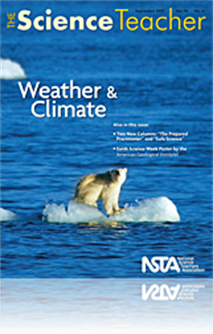All The Science Teacher resources
Journal Article
Idea Bank: Demonstrating the Self-Assembly of the Cell Membrane
Although the cell membrane is a complex structure, its basic form, and the self-organizing behavior of the molecules that produce it, can be easily simulated in a high school science classroom. One such simulation, described in this article, uses oil...
Journal Article
The Prepared Practitioner: Constructivism and Conceptual Change, Part I
Constructivism is the basis for standards, inquiry-based instruction, and a candidate for buzzword of the decade. But what is constructivism? This month’s column provides the answer to this thought-provoking question, and explains why it can be a c...
Journal Article
Current Taxonomy in Classroom Instruction
The ability to sequence genes has vastly altered our understanding of higher-level relationships among organisms such as those found at the kingdom level. It is important for biology teachers to incorporate these new views and not retain outdated con...
Journal Article
Career of the Month: An Interview with Space Architect Constance Adams
Drawing knowledge from many fields—including science, engineering, and art—space architects such as Constance Adams design structures for nonterrestrial environments. In one such project at NASA, Adams works on elements for the International Spac...
Journal Article
Nematodes: Model Organisms in High School Biology
In a collaborative effort between university researchers and high school science teachers, an inquiry-based laboratory module was designed using two species of insecticidal nematodes to help students apply scientific inquiry and elements of thoughtfu...
Journal Article
Fall Colors, Temperature, and Day Length
Along with the bright hues of orange, red, and yellow, the season of fall represents significant changes, such as day length and temperature. These changes provide excellent opportunities for students to use science process skills to examine how abio...
Journal Article
A Cooperative Classroom Investigation of Climate Change
Scientists have a particularly difficult time explaining warming trends in Antarctica—a region with a relatively short history of scientific observation and a highly variable climate (Clarke et al. 2007). Regardless of the mechanism of warming, how...
Journal Article
Numerous connections exist between climate science and topics normally covered in physics and physical science courses. For instance, lessons on heat and light can be used to introduce basic climate science, and the study of electric circuits provide...
Journal Article
The hydrologic cycle is a very basic scientific principle. In this article, background information is presented on how the hydrologic cycle provides scientists with clues to understanding the history of Earth’s climate. Also detailed is a web-based...



